Induction of Galphas contributes to the paradoxical stimulation of cytosolic phospholipase A2alpha expression by cortisol in human amnion fibroblasts
- PMID: 20203101
- PMCID: PMC5417499
- DOI: 10.1210/me.2009-0488
Induction of Galphas contributes to the paradoxical stimulation of cytosolic phospholipase A2alpha expression by cortisol in human amnion fibroblasts
Abstract
Cytosolic phospholipase A (cPLA(2alpha)) catalyzes the formation of arachidonic acid in prostaglandin synthesis. In contrast to the well-described down-regulation of cPLA(2alpha), up-regulation of cPLA(2alpha) by glucocorticoids has been reported in human amnion fibroblasts, which may play a key role in parturition. The mechanisms underlying this paradoxical induction of cPLA(2alpha) by glucocorticoids remain largely unknown. Using cultured human amnion fibroblasts, we found that the induction of cPLA(2alpha) by cortisol required ongoing transcription and synthesis of at least one other protein. The induction of cPLA(2alpha) by cortisol was abolished by mutagenesis of a glucocorticoid response element (GRE) in the promoter. The same GRE was found mediating the classical inhibition of cPLA(2alpha) expression by cortisol in human fetal lung fibroblasts (HFL-1). Cortisol increased Galpha(s) expression in amnion fibroblasts but not in HFL-1 cells. Inhibition of Galpha(s) with NF449 attenuated the phosphorylation of cAMP response element-binding protein-1 (CREB-1) and the induction of cPLA(2alpha) by cortisol in amnion fibroblasts. Both glucocorticoid receptor (GR) and CREB-1 were found bound to the GRE upon cortisol stimulation of amnion fibroblasts. The induction of cPLA(2alpha) by cortisol was blocked by GR antagonist RU486 or protein kinase A inhibitor H89 or dominant-negative CREB-1. In conclusion, cortisol activates the cAMP/protein kinase A/CREB-1 pathway via Galpha(s) induction, and the phosphorylated CREB-1 interacts with GR at the GRE to promote cPLA(2alpha) expression in amnion fibroblasts.
Figures
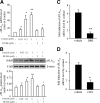


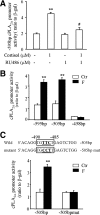

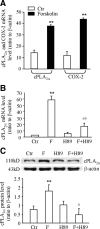
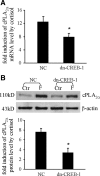
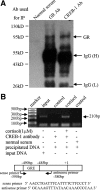
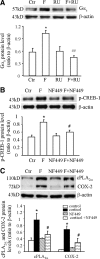

Similar articles
-
Induction of progesterone receptor A form attenuates the induction of cytosolic phospholipase A2alpha expression by cortisol in human amnion fibroblasts.Reproduction. 2010 May;139(5):915-22. doi: 10.1530/REP-10-0007. Epub 2010 Feb 15. Reproduction. 2010. PMID: 20156884
-
Paradox of glucocorticoid-induced cytosolic phospholipase A2 group IVA messenger RNA expression involves glucocorticoid receptor binding to the promoter in human amnion fibroblasts.Biol Reprod. 2008 Jan;78(1):193-7. doi: 10.1095/biolreprod.107.063990. Epub 2007 Sep 26. Biol Reprod. 2008. PMID: 17901074
-
Paradoxical stimulation of cyclooxygenase-2 expression by glucocorticoids via a cyclic AMP response element in human amnion fibroblasts.Mol Endocrinol. 2009 Nov;23(11):1839-49. doi: 10.1210/me.2009-0201. Epub 2009 Oct 1. Mol Endocrinol. 2009. PMID: 19797430 Free PMC article.
-
Localization and function of cytosolic phospholipase A2alpha at the Golgi.Biochimie. 2010 Jun;92(6):620-6. doi: 10.1016/j.biochi.2010.03.001. Epub 2010 Mar 10. Biochimie. 2010. PMID: 20226226 Free PMC article. Review.
-
Nongenomic cortisol signaling in fish.Gen Comp Endocrinol. 2018 Sep 1;265:121-127. doi: 10.1016/j.ygcen.2018.04.019. Epub 2018 Apr 16. Gen Comp Endocrinol. 2018. PMID: 29673844 Review.
Cited by
-
Induction of PGF2α synthesis by cortisol through GR dependent induction of CBR1 in human amnion fibroblasts.Endocrinology. 2014 Aug;155(8):3017-24. doi: 10.1210/en.2013-1848. Epub 2014 Mar 21. Endocrinology. 2014. PMID: 24654784 Free PMC article.
-
Role of redox signaling in neuroinflammation and neurodegenerative diseases.Biomed Res Int. 2013;2013:484613. doi: 10.1155/2013/484613. Epub 2013 Dec 24. Biomed Res Int. 2013. PMID: 24455696 Free PMC article. Review.
-
Molecular Mechanisms of Functional Adrenocortical Adenoma and Carcinoma: Genetic Characterization and Intracellular Signaling Pathway.Biomedicines. 2021 Jul 26;9(8):892. doi: 10.3390/biomedicines9080892. Biomedicines. 2021. PMID: 34440096 Free PMC article. Review.
-
Red blood cell signaling is functionally conserved in Plasmodium invasion.iScience. 2024 Sep 26;27(10):111052. doi: 10.1016/j.isci.2024.111052. eCollection 2024 Oct 18. iScience. 2024. PMID: 39635131 Free PMC article.
-
The involvement of phospholipases A2 in asthma and chronic obstructive pulmonary disease.Mediators Inflamm. 2013;2013:793505. doi: 10.1155/2013/793505. Epub 2013 May 13. Mediators Inflamm. 2013. PMID: 24089590 Free PMC article. Review.
References
-
- Saigal S, Doyle LW2008. Preterm birth 3: an overview of mortality and sequelae of preterm birth from infancy to adulthood. Lancet 371:261–269 - PubMed
-
- Creasy RK1991. Preventing preterm birth. N Engl J Med 325:727–729 - PubMed
-
- Gibb W1998. The role of prostaglandins in human parturition. Ann Med 30:235–241 - PubMed
-
- Challis JR, Lye SJ, Gibb W1997. Prostaglandins and parturition. Ann NY Acad Sci 828:254–267 - PubMed
-
- Duchesne MJ, Thaler-Dao H, de Paulet AC1978. Prostaglandin synthesis in human placenta and fetal membranes. Prostaglandins 15:19–42 - PubMed
Publication types
MeSH terms
Substances
LinkOut - more resources
Full Text Sources
Research Materials

